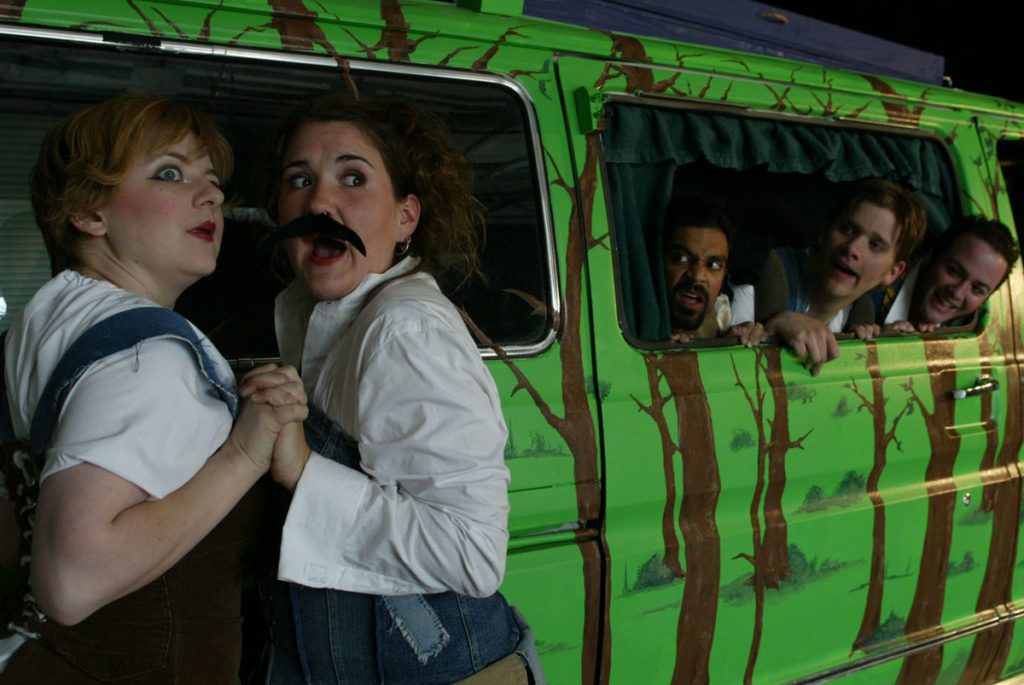In its version of Shakespeare’s Titus Andronicus, the six-member troupe twists a tragic tale of revenge and deceit into a manic, melodramatic musical, filled with oodles of fake blood, clever pop-song covers and abundant sarcasm.The Bard is never boring in the hands of the capable Buntport Theater clan.
It’s far from the traditional Titus but tons more fun.
Buntport presents the play as a band of roving performers (known as the Van-O-Players), harking back to the vagabond troupes who traveled the countryside in Shakespeare’s day. The Van-O-Players carry props, costumes, a musician and a player piano in their dilapidated but colorful vehicle — the essentials for making light of one of the Bard’s least-liked works.
Because they’re few in number, each player takes on multiple roles, transitioning from character to character by donning a fake beard, cowboy hat or other silly prop. The group’s musician (the multitalented Muni Kulasinghe) plays such a vast array of characters that he pastes strips of paper to his chest to indicate which personality he’s portraying at any given time. He also tracks the play’s mounting death toll on a small black chalkboard.
The Van-O-Players present an abbreviated adaptation of Titus but stick somewhat closely to the play’s plotline, which details the downfall of a Roman general in a Melrose Place-type fashion.
The Buntport tribe (made up of Brian Colonna, Erik Edborg, Hannah Duggan, Erin Rollman and their offstage counterparts Matt Petraglia and Samantha Schmitz) have a grand time poking fun at this poorly constructed play.
The groups shrewdly sprinkle songs throughout the scenes to highlight the absurdity of specific characters and situations. The new emperor, for example, celebrates his ascension with ragtime playing in the background, his loyal subjects dancing around him sporting toothy smiles and jazz hands.
A plotting lover sings about seeking revenge for his sweetheart over a cover of ABBA’s Fernando, chatting up murderers while doing the cha-cha.
Even versions of Bobby Darrin’s Beyond the Sea and Britney Spears’ Oops I Did it Again make appearances.
The props also provide comic relief. Two characters are portrayed by hand puppets; one is made of a rusty gas can, and the other is an old car radio with a shoeshine brush serving as a spiky hair covered head.
Blood is bountiful, pouring like a river out of the performer’s guts, mouths, hands, etc. By the end of the play, the actors could easily double as extras for the next Scream sequel.
And the show has a surprisingly high production value, considering that the troupe’s psychedelic van is the set. With scenes painted on its sides, the vehicle serves as a grand palace one minute, a lush, green forest the next.
But gimmicks aside, what makes this spoof succeed is the cast’s commitment. The performers are consistently solid, from Rollman as the devilishly delightful Queen Tamora (who punctuates nearly every scene with a wicked laugh) to Kulasinghe, who sprints between characters with Michael Lewis like speed.
But hurry if you want to see the Bard’s bloodiest play performed Buntport Theater style. The show, postponed by two weeks because of Colonna’s emergency appendectomy, will end its run Sunday.
-Erika Gonzalez, May 17, 2002, Rocky Mountain News








